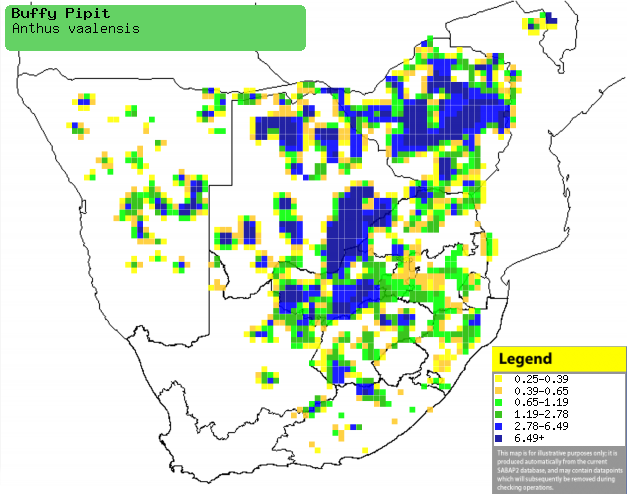|
Anthus vaalensis (Buffy
pipit)
Vaalkoester [Afrikaans]; Tšase (generic term for
pipits) [South Sotho]; Vaal-rivierpieper [Dutch]; Pipit du Vaal [French];
Vaalpieper [German]; Petinha do Vaal [Portuguese]
Life
> Eukaryotes >
Opisthokonta
> Metazoa (animals) >
Bilateria >
Deuterostomia > Chordata >
Craniata > Vertebrata (vertebrates) > Gnathostomata (jawed
vertebrates) > Teleostomi (teleost fish) > Osteichthyes (bony fish) > Class:
Sarcopterygii (lobe-finned
fish) > Stegocephalia (terrestrial
vertebrates) > Tetrapoda
(four-legged vertebrates) > Reptiliomorpha > Amniota >
Reptilia (reptiles) >
Romeriida > Diapsida > Archosauromorpha > Archosauria >
Dinosauria
(dinosaurs) > Saurischia > Theropoda (bipedal predatory dinosaurs) >
Coelurosauria > Maniraptora > Aves
(birds) > Order: Passeriformes
> Family: Motacillidae > Genus: Anthus
Distribution and habitat
Occurs in sub-Equatorial Africa from southern DRC through
Zambia, Malawi and Angola to southern Africa. Here it is locally common from
Mozambique to South Africa (excluding the fynbos and Karoo biomes of the west),
Botswana and Namibia, marginally extending into Mozambique. It generally prefers
open grassy plains with patches of bare ground, overgrazed land, fallow
pastures, recently burnt fields and the edges of pans.
|
 |
|
Distribution of Buffy pipit in southern Africa,
based on statistical smoothing of the records from first SA Bird Atlas
Project (©
Animal Demography unit, University of
Cape Town; smoothing by Birgit Erni and Francesca Little). Colours range
from dark blue (most common) through to yellow (least common).
See here for the latest distribution
from the SABAP2. |
Movements and migrations
Sometimes nomadic in the dry season, moving in
search of areas which have experienced recent rainfall.
Food
It mainly eats insects and other invertebrates, doing most
of its foraging on the ground. The following food items have been recorded
in its diet:
Breeding
- The nest (see image below) is an untidy cup of coarse grass, lined with
fine grass and rootlets and placed in a hollow at the base of a grass tuft
or rock overhang.
 |
|
|
Buffy pipit nest with eggs, Sericea farm,
South Africa. [photo Warwick Tarboton ©] |
|
- Egg-laying season is from July-February, peaking from September-December.
- It lays 2-3 eggs, which are incubated for 14 days.
- The chicks are fed by both parents, leaving the nest after about 12
days.
Threats
Not threatened, in fact it at has adapted well to
overgrazing and agriculture.
References
-
Hockey PAR, Dean WRJ and Ryan PG 2005. Roberts
- Birds of southern Africa, VIIth ed. The Trustees of the John Voelcker
Bird Book Fund, Cape Town.
|
